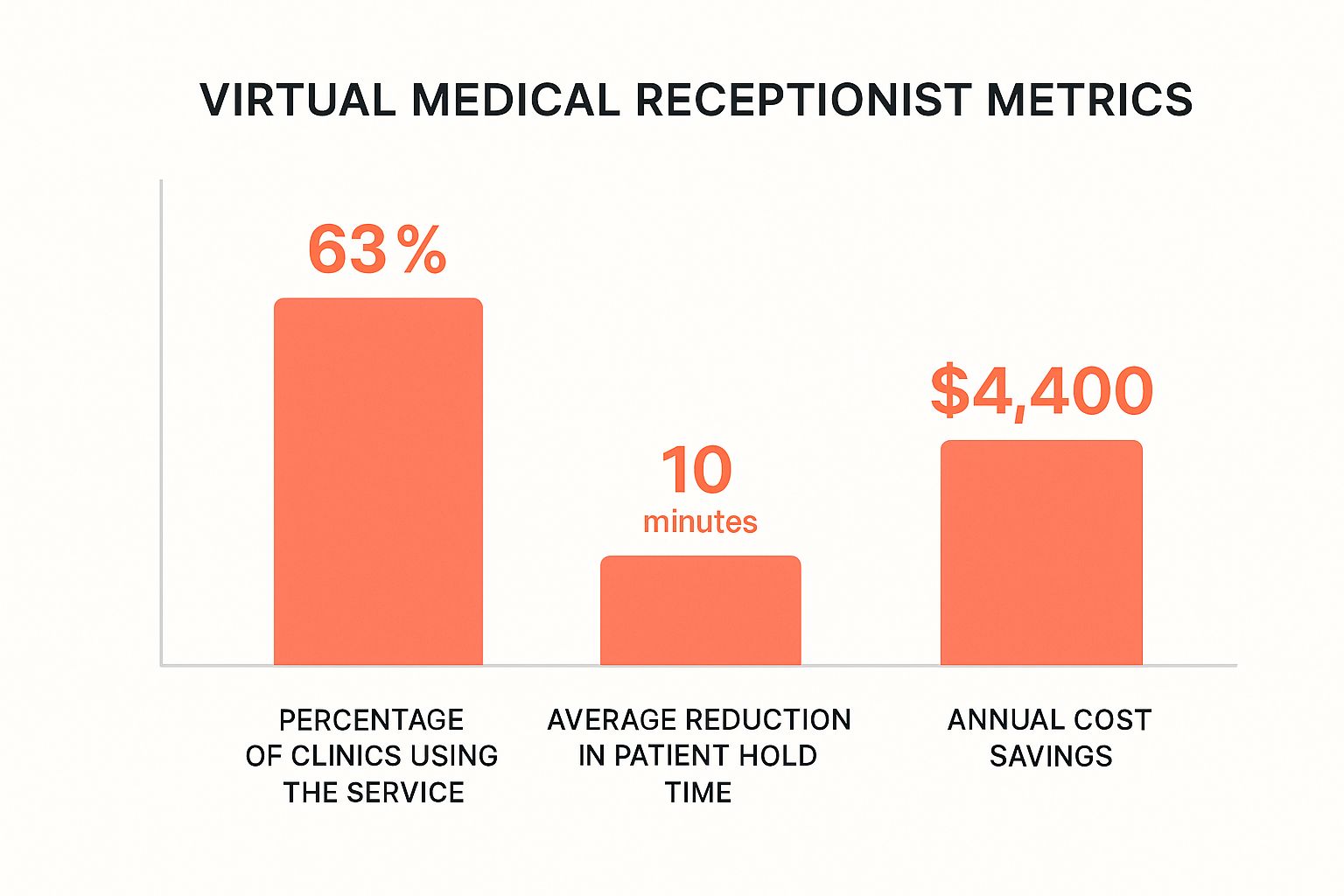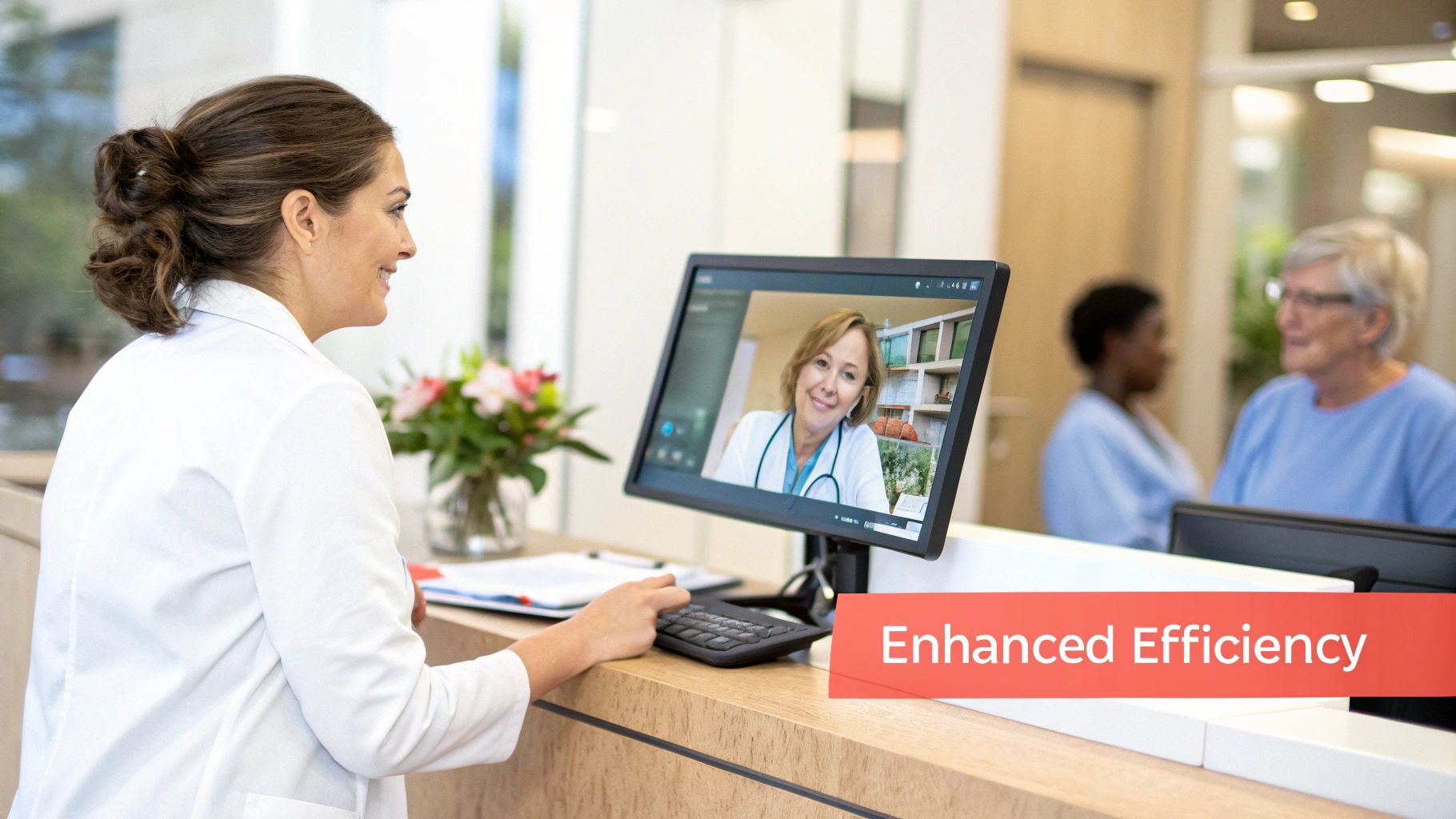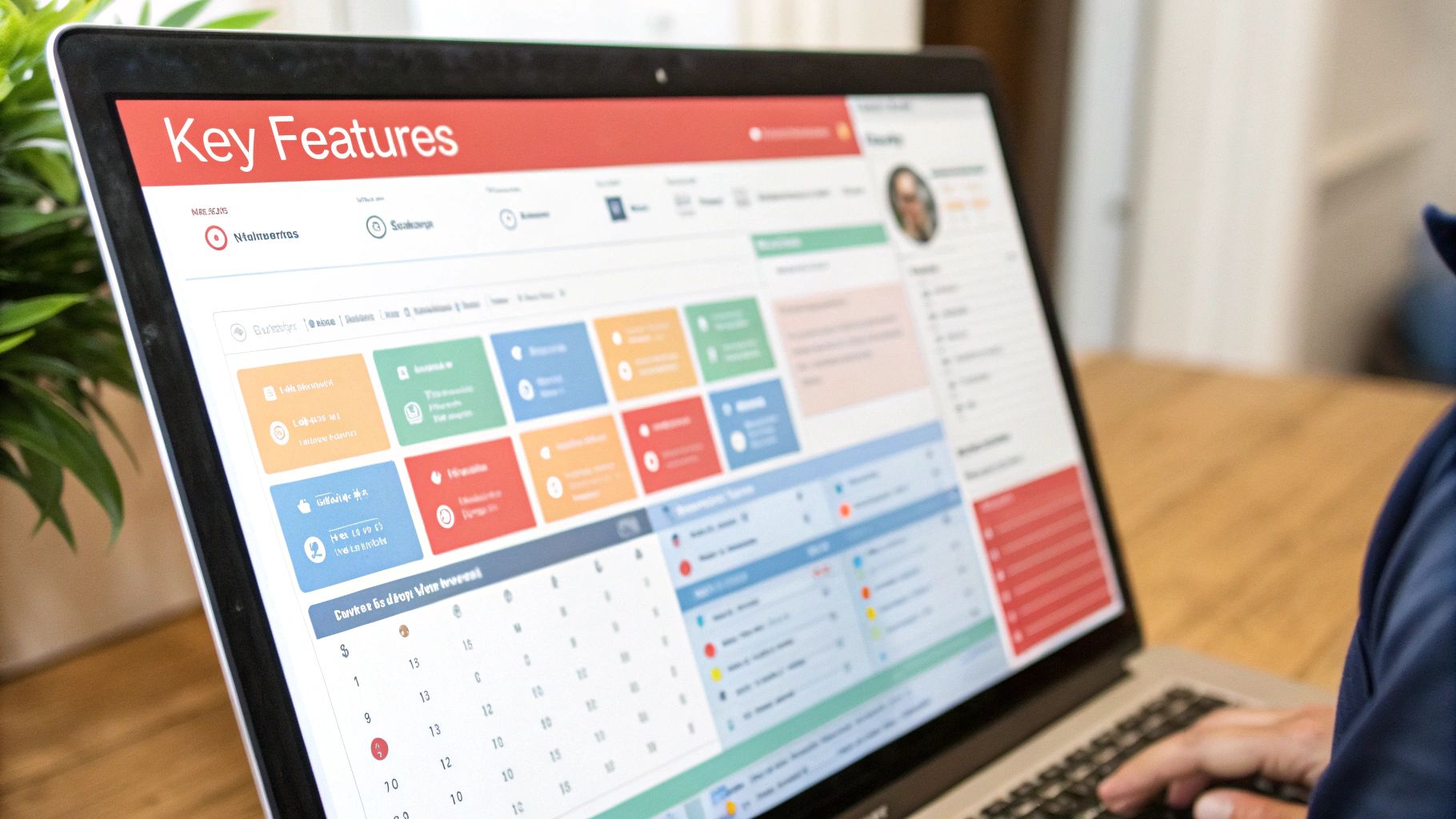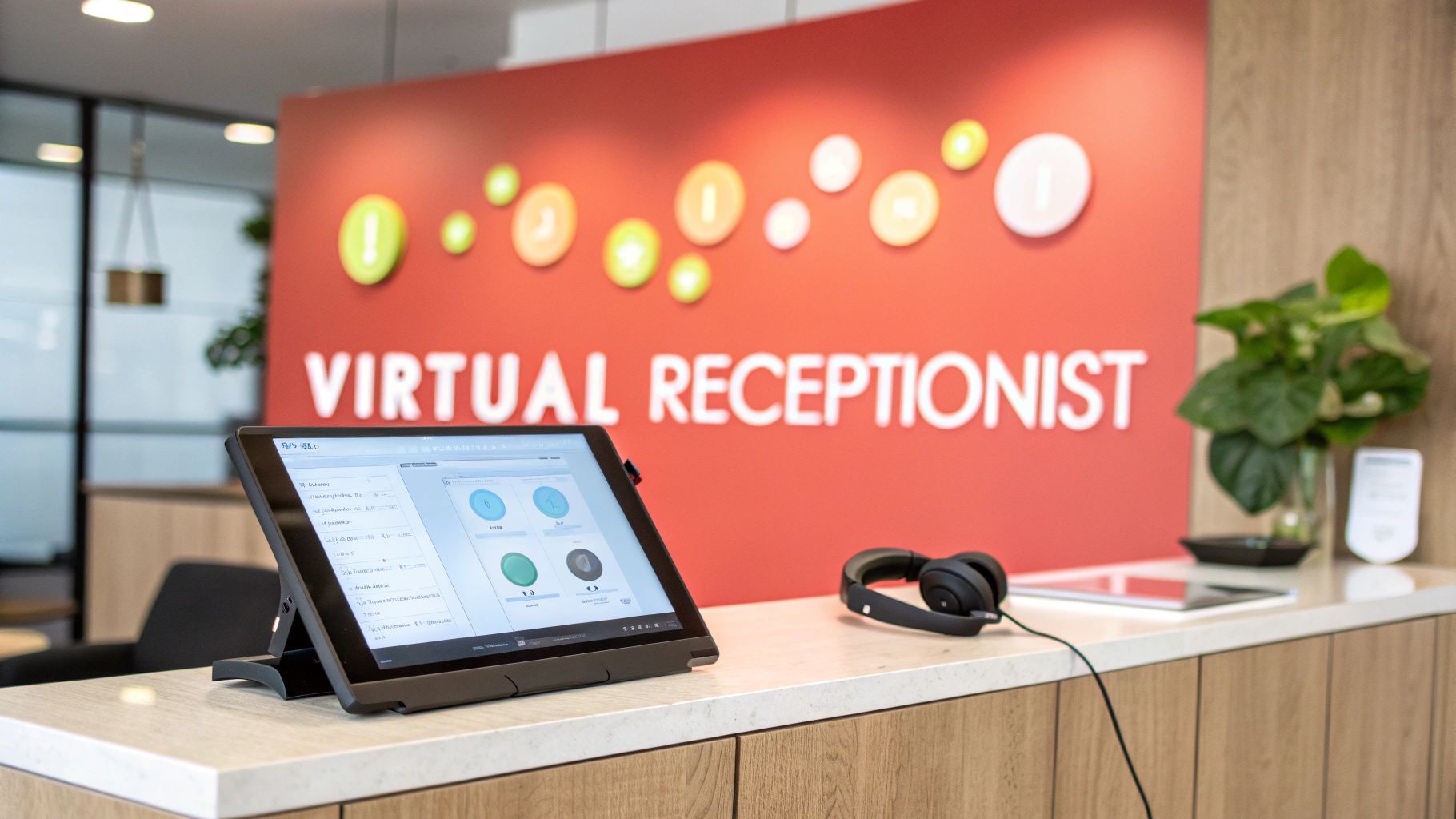Beyond The Front Desk: The Virtual Medical Receptionist Revolution

The infographic above highlights the growing presence of virtual medical receptionists in clinics today. It showcases key metrics like adoption rates, average reductions in patient hold times, and potential annual cost savings. The data suggests significant improvements in efficiency and tangible financial benefits for practices that integrate these systems.
This shift represents more than just a digital upgrade to the traditional receptionist role. It fundamentally changes how medical practices interact with their patients, improving communication and streamlining operations. Virtual medical receptionists are AI-powered systems that utilize technologies like natural language processing (NLP) and context-aware AI.
These tools go far beyond the capabilities of simple chatbots or automated phone menus. They can handle more complex and nuanced patient inquiries, providing real value to both patients and staff. For instance, a virtual receptionist can differentiate between a routine check-up request and an urgent appointment, prioritizing and routing calls appropriately.
Redefining Patient Interaction With Intelligent Automation
Intelligent appointment scheduling is a key benefit of virtual medical receptionists. These systems access real-time appointment availability, incorporating physician preferences, patient history, and even insurance information into the booking process.
This advanced functionality leads to more efficient scheduling and reduces the administrative burden on staff. Furthermore, virtual receptionists provide personalized patient interactions, maintaining a human touch while freeing up human staff for other essential tasks. This allows practices to retain a compassionate and empathetic approach to patient communication without sacrificing efficiency.
To better understand the differences between traditional and virtual receptionists, let’s examine their capabilities side-by-side. The table below provides a comparison across various healthcare functions.
Traditional vs. Virtual Medical Receptionists
This table compares the capabilities, limitations, and benefits of traditional human receptionists versus AI-powered virtual medical receptionists across various healthcare functions.
| Function | Traditional Receptionist | Virtual Medical Receptionist | Key Differences |
|---|---|---|---|
| Appointment Scheduling | Manually schedules appointments based on available slots. | Automates scheduling based on real-time availability, physician preferences, and patient information. | Automation, efficiency, and reduced scheduling errors. |
| Patient Communication | Answers calls, provides basic information, and takes messages. | Provides 24/7 support, answers common questions, and offers personalized communication. | Increased availability, consistent messaging, and automated responses. |
| Call Handling | Manages incoming and outgoing calls, routes calls to appropriate staff. | Prioritizes calls based on urgency and context, routes calls efficiently, and reduces hold times. | Improved call routing and reduced wait times. |
| Administrative Tasks | Manages paperwork, updates patient records, and handles other administrative duties. | Can integrate with other systems to automate administrative tasks and update patient information. | Increased automation and reduced administrative burden. |
| Availability | Limited to business hours. | 24/7 availability. | Enhanced accessibility for patients. |
As you can see, while traditional receptionists offer a personal touch, virtual receptionists excel in automation, efficiency, and 24/7 availability. This combination of human and AI-powered support can significantly enhance the patient experience.
Addressing Misconceptions And Highlighting Real-World Applications
Some practices hesitate to adopt virtual receptionists due to concerns about their perceived impersonal nature. However, modern systems are designed with empathetic and personalized communication in mind. Advanced NLP and machine learning allow these tools to understand the context of calls and tailor responses accordingly.
Practices can further customize these systems to align with their brand and preferred communication style. This creates a seamless and natural experience for patients while offering the convenience of 24/7 support. The growing market for virtual receptionist services reflects the increasing recognition of their value. The healthcare virtual assistants market was valued at USD 1.03 billion in 2023 and is projected to reach USD 12.99 billion by 2032, with a CAGR of 33.24%. Find more detailed statistics here. This growth is fueled by the rising demand for teleconsultations and automated communication in healthcare.
The Future Of Healthcare Communication
Virtual medical receptionists are transforming healthcare communication. From handling fluctuating call volumes to gathering valuable insights into patient communication patterns, these systems are empowering practices to improve patient access, enhance operational efficiency, and ultimately, provide better care. By adopting these technologies, practices can position themselves for success in the evolving landscape of patient-centered care.
The Business Case for Virtual Medical Receptionists

Beyond the initial appeal of new technology, medical practices must consider the practical benefits. The value proposition of virtual medical receptionists lies in tangible improvements like cost reduction and increased efficiency. These advantages are not just theoretical; practices are experiencing real, positive impacts on their bottom line.
For instance, 24/7 patient access dramatically improves patient satisfaction and reduces no-shows. This constant availability allows patients to schedule appointments, ask questions, and manage their healthcare needs on their own time. This improved patient experience also leads to fewer missed appointments, as patients can easily reschedule or receive timely reminders.
In addition, virtual medical receptionists free up existing staff. Instead of handling routine tasks like answering basic inquiries or scheduling, your team can focus on complex patient interactions requiring a personal touch. This not only boosts staff morale but also allows for more focused and effective patient care.
Quantifying the ROI of Virtual Receptionists
The financial advantages go beyond increased efficiency. Many practices experience significant cost savings by reducing the need for a large in-house reception team. This overhead reduction is particularly impactful for smaller practices or those with tight budgets. Moreover, virtual receptionists can manage fluctuating call volumes without impacting service quality. Whether a sudden influx of calls during flu season or simply a busy day, these systems ensure prompt and efficient service for every patient.
The data gathered by virtual medical receptionists also offers valuable insights into patient communication trends. This information allows practices to optimize their communication strategies, identify areas for improvement, and tailor services to better meet patient needs. This data-driven approach empowers practices to make informed decisions and continually refine their operations. The global healthcare chatbot market, encompassing virtual medical receptionists, has seen substantial growth. By 2025, this market exceeded $1 billion, demonstrating a significant increase in AI-driven healthcare solutions. This growth highlights the demand for efficient patient communication and engagement. Explore this topic further.
Impact on Patient Care and Staff Wellbeing
Consider a system seamlessly integrated with your existing Electronic Health Records (EHR) system, automating patient intake and insurance verification. This is the reality for many practices employing virtual receptionist technology. This integration streamlines workflows, reduces administrative burdens, and ensures HIPAA compliance throughout patient communications.
This not only benefits the practice but also directly enhances patient care by reducing wait times and improving access. It empowers staff by eliminating tedious tasks, decreasing burnout and increasing job satisfaction. This positive impact translates to better patient interactions and a more positive overall experience. Integrating these systems allows practices of all sizes to prioritize high-quality care while optimizing operational efficiency. By adopting virtual receptionist technology, medical practices are not just implementing a new tool, but investing in a more efficient, patient-centered future.
Must-Have Features in Your Virtual Medical Receptionist

Choosing the right virtual medical receptionist system requires careful consideration of its features. These features are essential for maximizing efficiency and elevating the patient experience. This section will guide you through the core capabilities that truly optimize practice operations.
Appointment Management: Beyond Basic Scheduling
An effective virtual medical receptionist goes beyond simple appointment booking. It should offer intelligent triage, routing patients based on the urgency of their needs. For example, a patient with a severe allergic reaction should be prioritized over a routine check-up.
Priority management is also crucial. The system should identify and flag urgent cases, ensuring prompt attention. Automated reminders and follow-ups are essential for reducing no-shows and improving patient adherence to treatment plans.
Seamless Integration and Customization
Secure integration with your existing Electronic Health Record (EHR) system is paramount. This interoperability ensures seamless data flow, reducing manual entry and minimizing errors. Patient information is readily available, enabling personalized and efficient service.
Customization is equally important. The system should adapt to your practice’s specific needs and branding. This includes personalized greetings, custom messaging, and integration with your website and patient portal.
Automation and Compliance: Streamlining Workflows
Patient intake automation is a key feature. This includes collecting demographics, insurance information, and medical history. Automating these tasks frees up staff for more complex patient needs.
Insurance verification is another vital automation feature. Real-time verification simplifies billing and reduces claim denials. Maintaining HIPAA compliance across all communications is non-negotiable. The system must adhere to strict privacy regulations to protect patient information.
To help you evaluate potential solutions, we’ve compiled a table outlining the most important features of a virtual medical receptionist. The table ranks these features by importance and implementation complexity, considering their impact on both patients and staff.
Essential Virtual Medical Receptionist Features:
This table presents the most important features to evaluate when selecting a virtual medical receptionist solution, ranked by priority and implementation complexity.
| Feature | Importance Level | Implementation Complexity | Patient Impact | Staff Impact |
|---|---|---|---|---|
| 24/7 Availability | High | Low | Increased Access | Reduced Workload |
| Appointment Scheduling & Reminders | High | Low | Convenience | Improved Efficiency |
| Insurance Verification | High | Medium | Reduced Billing Issues | Streamlined Processes |
| EHR Integration | High | Medium | Data Accuracy | Reduced Errors |
| HIPAA Compliance | Essential | High | Data Security | Legal Protection |
| Multilingual Support | Medium | Medium | Improved Accessibility | Broader Reach |
| Customized Messaging | Medium | Low | Personalized Experience | Brand Consistency |
| Call Triage & Prioritization | High | Medium | Improved Response Times | Efficient Workflow |
As you can see, features like 24/7 availability and appointment management offer significant benefits with relatively low implementation complexity. Other features, such as EHR integration and HIPAA compliance, while crucial, may require more effort to implement. Balancing these factors is key to selecting the right system for your practice.
Simbie AI incorporates many of these crucial features, offering a robust solution for practices looking to optimize their operations and enhance patient communication. Choosing the right virtual receptionist is an investment in the future of efficient, patient-centered care.
Implementing Your Virtual Medical Receptionist: A Roadmap
Transitioning to a virtual medical receptionist requires careful planning and execution. This roadmap, drawing on the experiences of practices already utilizing this technology, provides a guide for successful implementation.
Needs Assessment and Vendor Selection
Start by thoroughly evaluating your practice’s specific needs. Pinpoint existing communication bottlenecks. Are patients frustrated by extended hold times, limited after-hours accessibility, or scheduling inefficiencies? Whenever possible, quantify these issues. For instance, track the average time patients spend on hold or the number of missed appointments caused by scheduling problems.
Next, research providers of virtual medical receptionist services. Go beyond marketing materials and ask critical questions. How well does the system integrate with your current Electronic Health Record (EHR) system? What level of customization is offered? What security protocols are in place to safeguard patient data?
The healthcare virtual assistant market is experiencing significant growth, projected to reach USD 10.01 billion by 2037, expanding at a CAGR of approximately 26.2%. Discover more insights about this growing market. This growth underscores the increasing need for automated communication and enhanced patient engagement. Selecting the right vendor requires careful consideration and a clear understanding of your practice’s requirements.
Staff Buy-In and Data Migration
Securing staff buy-in is crucial. Address any staff anxieties regarding job security or workflow changes. Emphasize that the virtual receptionist is intended to support staff, not replace them. Highlight how automation can free up their time for more valuable patient interactions.
Data migration requires meticulous planning to minimize disruptions. Collaborate closely with your vendor to ensure a seamless transfer of existing patient information and scheduling data. Establish clear communication channels between your staff and the vendor’s support team.
Training and Implementation Timeline
Comprehensive training is essential for a successful implementation. Provide thorough training to all staff members who will interact with the virtual receptionist system. Focus on the system’s features, functionality, and its integration with existing workflows.
Implementation timelines vary depending on the size and complexity of the practice. A smaller practice may complete implementation within a few weeks, whereas a larger healthcare system may need several months. Create a realistic timeline with defined milestones and allocate sufficient resources for each phase.
Measuring Success and Ongoing Optimization
Define key performance indicators (KPIs) to monitor the effectiveness of your virtual medical receptionist. Track metrics like patient wait times, appointment scheduling efficiency, and patient satisfaction. Regularly review these metrics and make necessary adjustments.
Implementing a virtual medical receptionist is an ongoing process. Continuously monitor performance, gather feedback from both staff and patients, and collaborate with your vendor to optimize the system to meet your practice’s specific needs. Following this roadmap can help you successfully integrate a virtual medical receptionist and enhance patient communication.
Overcoming Patient and Staff Resistance to Virtual Receptionists

Implementing new technology, such as a virtual medical receptionist, can sometimes be met with resistance from both patients and staff. This often comes from unfamiliarity with the technology, concerns about job security, and a perceived loss of personal care. However, these concerns can be effectively addressed through open communication and a well-planned implementation strategy.
Addressing Patient Concerns
Patients may be hesitant about interacting with a virtual receptionist instead of a human. Healthcare is personal, and this concern is understandable. However, highlighting the benefits of virtual receptionists can ease these worries. For instance, 24/7 availability for appointment scheduling and answering general questions can be a significant advantage for patients. This is particularly true for those who find it difficult to contact the practice during normal business hours.
It’s important to emphasize that a virtual receptionist enhances, not replaces, human interaction. Explain that it handles routine tasks, freeing up staff to provide more focused, personalized care during appointments. Transparency is key. Clearly inform patients when they are interacting with a virtual receptionist and ensure a seamless transition to a human staff member when needed for more complex issues.
Easing Staff Apprehensions
Staff resistance often stems from fears about job displacement. Reassure staff that the virtual receptionist is designed to support them, not replace them. Explain how automating repetitive administrative tasks allows them to concentrate on patient care and more complex interactions.
This shift can also lead to greater job satisfaction. By reducing burnout and allowing staff to use their skills more effectively, a virtual receptionist can improve the overall work experience. Comprehensive training on the new system is essential. This not only equips staff to use the technology effectively, but also empowers them to adapt to the changing workflow.
Ensuring Smooth Integration and Data Security
Seamless integration with existing systems is vital for successful adoption. Ensure the virtual receptionist integrates smoothly with your practice’s Electronic Health Record (EHR) and other essential software. This streamlined integration reduces manual data entry and helps maintain data integrity.
Data security, particularly concerning HIPAA compliance, is paramount. Clearly communicate the security measures in place, emphasizing patient data protection. Transparency about security protocols builds trust with both staff and patients. Simbie AI prioritizes HIPAA-compliant security, ensuring all patient communications are protected.
Turning Resistance into Enthusiasm: Real-World Examples
Many practices have successfully overcome initial resistance to virtual receptionists. By demonstrating tangible benefits, they’ve transformed skepticism into enthusiasm. One practice, for example, reported significantly higher patient satisfaction scores after implementing a virtual receptionist, primarily due to reduced hold times.
Another practice highlighted how their initially hesitant staff came to appreciate the reduced workload and increased time for patient interaction. These real-world success stories demonstrate how virtual medical receptionists can improve practice workflows and enhance patient care. By focusing on clear communication, comprehensive training, and a patient-centered approach, practices can successfully implement this technology and achieve widespread acceptance.
The Future of Virtual Medical Receptionists: Beyond Scheduling
The role of the virtual medical receptionist is evolving rapidly. It’s moving beyond basic scheduling and administrative tasks, driven by continuous innovation in healthcare technology. This promises a future of more personalized, efficient, and proactive patient engagement.
The Rise of Empathetic Virtual Interactions
Imagine a virtual receptionist that understands not only your words but also your emotional state. Through sentiment analysis, these advanced systems can detect nuances in a patient’s voice. They can identify frustration, anxiety, or urgency, allowing the virtual receptionist to tailor responses appropriately. It might offer reassurance or prioritize urgent calls. This emerging field of emotional intelligence in AI is creating surprisingly empathetic virtual interactions, enhancing the patient experience.
Voice recognition combined with contextual understanding enables more natural conversations. These systems go beyond simple keyword recognition to understand the intent behind patient requests. They can handle complex inquiries and provide relevant information across multiple channels. This includes phone calls, text messages, and online portals.
Predictive Analytics and Proactive Patient Care
Virtual receptionists are becoming increasingly proactive. Predictive analytics allows these systems to anticipate patient needs. By analyzing patient history and communication patterns, virtual receptionists can identify potential issues and offer preemptive solutions. For example, they might proactively schedule a follow-up appointment for a patient with a chronic condition. Or, they might remind a patient about an upcoming vaccination.
Under appropriate supervision, virtual receptionists are starting to take on preliminary clinical support functions. These include medication reminders, collecting basic health information, and providing personalized patient education. This frees up human staff to focus on more complex medical tasks, improving efficiency and patient care.
Seamless Coordination Across the Healthcare Ecosystem
Interoperability is another key area of advancement. Pilot programs show how improvements in interoperability enable seamless coordination between virtual receptionists and the broader healthcare ecosystem. This integration allows the secure exchange of patient information between different systems, such as Electronic Health Records (EHRs), pharmacies, and laboratories. This streamlined flow of information ensures data accuracy and eliminates manual data entry. It reduces administrative burdens and potential errors.
A virtual receptionist could confirm a patient’s insurance coverage, schedule an appointment with a specialist, and send prescription information to the patient’s preferred pharmacy – all within a single interaction. This level of integration enhances the patient experience and improves the overall efficiency of the healthcare system.
Simbie AI is at the forefront of these advancements. They offer a clinically trained, voice-based AI platform designed to optimize patient interactions and automate routine administrative tasks. Contact them to learn how Simbie AI can transform your practice and enhance patient care.

